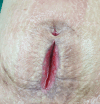Severe Complications of Uterine Dehiscence Post-Lower Segment Cesarean Section: A Case Report Emphasizing the Importance of Timely Diagnosis and Intervention
- PMID: 38796696
- PMCID: PMC11138370
- DOI: 10.12659/AJCR.943027
Severe Complications of Uterine Dehiscence Post-Lower Segment Cesarean Section: A Case Report Emphasizing the Importance of Timely Diagnosis and Intervention
Abstract
BACKGROUND Uterine dehiscence, an infrequent event often mistaken for uterine rupture, is rarely linked to post-cesarean section procedures and can result in severe complications, notably puerperal sepsis. In this report, we present a case that exemplifies the onset of puerperal sepsis and the emergence of intra-abdominal abscesses attributed to uterine dehiscence following a lower segment cesarean section (LSCS). CASE REPORT Our patient, a 28-year-old woman in her third pregnancy, underwent LSCS 1 week earlier. Subsequently, she returned to the hospital with lower abdominal pains, fever, and malodorous vaginal discharge. Computed tomography (CT) scan of whole abdomen verified uterine dehiscence and pus collection at the subhepatic region and right paracolic gutter. After referral to a specialized hospital, laboratory findings indicated an elevated white blood cell count and alkaline phosphatase levels, and coagulation abnormalities. She underwent an exploratory laparotomy, which unveiled uterine dehiscence, abscesses, and adhesions, necessitating a total abdominal hysterectomy and abdominal toileting. Pus culture analysis identified the presence of E. coli, which was susceptible to ampicillin/sulbactam. Complications were encountered after surgery, including wound dehiscence and pus re-accumulation. Successful management involved vacuum dressings and percutaneous drainage. Eventually, her condition improved and she was discharged, without additional complications. CONCLUSIONS This report underscores the importance of considering cesarean scar dehiscence as a diagnosis in women with previous cesarean deliveries who present during subsequent pregnancies with symptoms such as abdominal pain or abdominal sepsis. Diagnostic tools, such as CT, play pivotal roles, and the timely performance of an exploratory laparotomy is paramount when suspicion arises.
Conflict of interest statement
Figures










References
-
- World Health Orginization Caesarean section rates continue to rise, amid growing inequalities in access. 2021. Available from: https://www.who.int/news/item/16-06-2021-caesarean-section-rates-continu....
-
- Diaz SD, Jones JE, Seryakov M, Mann WJ. Uterine rupture and dehiscence: Ten-year review and case-control study. South Med J. 2002;95(4):431–35. - PubMed
-
- Wagner MS, Bédard MJ. Postpartum uterine wound dehiscence: A case report. J Obstet Gynaecol Can. 2006;28(8):713–15. - PubMed
Publication types
MeSH terms
LinkOut - more resources
Full Text Sources
Medical

